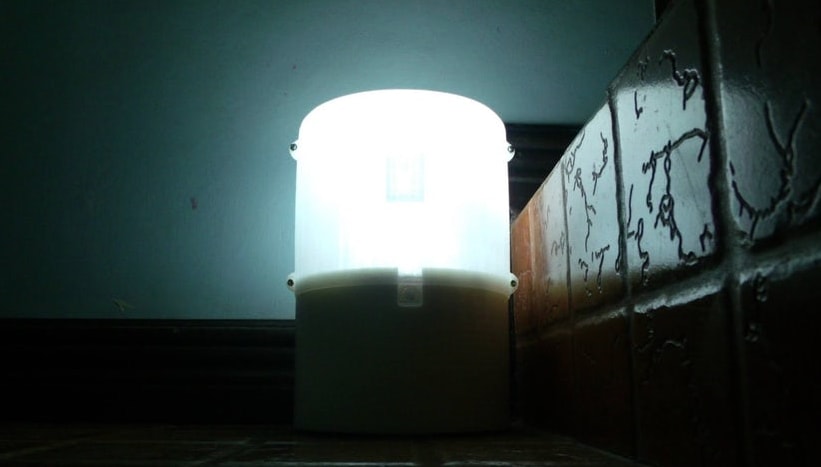Electrical
Salt Light Lamp
Dhilan Mandaliya

The idea behind this project salt lamp is the chemical conversion of energy. It utilizes the scientific process behind the Galvanic cell, but instead of electrolytes, the SALt lamp uses saline solution, making it harmless and non-toxic.
SALt lamp project is an LED lamp powered by the galvanic reaction of an anode with saline water. It also has a USB port to charge low-power mobile devices such as cellphones, smartphones, and mp3 players.The anode must be replaced approximately every six months and the saline water daily; sea water is usable.
Read more..
It is an environment-friendly and sustainable alternative light source that runs on saltwater, making it suitable to those who live in coastal areas.It can also function well in remote barrios. With just two tablespoons of salt and one glass of tap water, this ecologically designed lamp can run for eight hours.
“It is made of tediously experimented and improved chemical compounds, catalysts, and metal alloys that when submerged in electrolytes will generate electricity,
Project Description:
- Plastic box: For storage of salt water and galvanized plated
- 2 Glass of water: Water is a transparent, tasteless, odorless, and nearly colorless chemical substance that is the main constituent of Earth's streams, lakes, and oceans, and the fluids of most living organisms. Its chemical formula is H2O, meaning that each of its molecules contains one oxygen and two hydrogen atoms that are connected by covalent bonds. Strictly speaking, water refers to the liquid state of a substance that prevails at standard ambient temperature and pressure; but it often refers also to its solid state (ice) or its gaseous state (steam or water vapor). It also occurs in nature as snow, glaciers, ice packs and icebergs, clouds, fog, dew, aquifers, and atmospheric humidity
- voltage regulator: A voltage regulator is an electronic circuit that provides a stable DC voltage independent of the load current, temperature and AC line voltage variations. A voltage regulator may use a simple feedforward design or may include negative feedback. It may use an electromechanical mechanism or electronic components.
- LiPo Battery: =A lithium polymer battery, or more correctly lithium-ion polymer battery (abbreviated as LiPo, LIP, Li-poly, lithium-poly and others), is a rechargeable battery of lithium-ion technology using a polymer electrolyte instead of a liquid electrolyte. High conductivity semisolid (gel) polymers form this electrolyte. These batteries provide higher specific energy than other lithium battery types and are used in applications where weight is a critical feature, like tablet computers, cellular telephone handsets and radio-controlled aircraft
 Did you know
Did you know
Skyfi Labs helps students learn practical skills by building real-world projects.
You can enrol with friends and receive kits at your doorstep
You can learn from experts, build working projects, showcase skills to the world and grab the best jobs.
Get started today!
- 2 spoon salt : = Table salt or common salt is a mineral composed primarily of sodium chloride (NaCl), a chemical compound belonging to the larger class of salts; salt in its natural form as a crystalline mineral is known as rock salt or halite. Salt is present in vast quantities in seawater, where it is the main mineral constituent. The open ocean has about 35 grams (1.2 oz) of solids per litre, a salinity of 3.5%.
- 4 LED : = A light-emitting diode (LED) is a two-lead semiconductor light source. It is a p–n junction diode that emits light when activated.[5]When a suitable current is applied to the leads,] electrons are able to recombine with electron holes within the device, releasing energy in the form of photons. This effect is called electroluminescence, and the color of the light (corresponding to the energy of the photon) is determined by the energy band gap of the semiconductor. LEDs are typically small (less than 1 mm2) and integrated optical components may be used to shape the radiation pattern.
- Galvanic cells: = A galvanic cell, or voltaic cell, named after Luigi Galvani, or Alessandro Volta respectively, is an electrochemical cell that derives electrical energy from spontaneous redox reactions taking place within the cell. It generally consists of two different metals connected by a salt bridge, or individual half-cells separated by a porous membrane.
Application
Tracking/ Advanture
To fullfil basic needs
long trip or forest walk
can use where there is no power source
Congratulation
You have successfully generated flashlight with the Saltwater without using Battery.you can access free energy just by using ocean water.
Latest projects on Electrical
Want to develop practical skills on Electrical? Checkout our latest projects and start learning for free
Kit required to develop Salt Light Lamp:
Technologies you will learn by working on Salt Light Lamp:
Salt Light Lamp
Skyfi Labs
•
Published:
2018-05-19 •
Last Updated:
2022-05-20
 Looking to build projects on Electrical?:
Looking to build projects on Electrical?:
 Did you know
Did you know